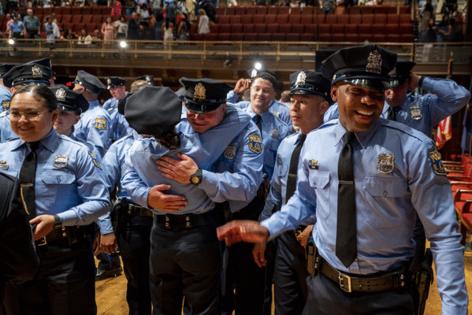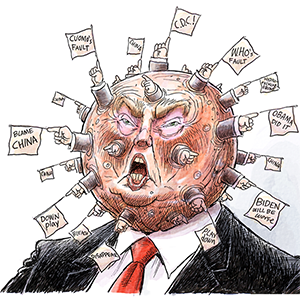Bye-bye, baby blue: Philly police are getting new uniforms. Not everyone is happy
Published in News & Features
PHILADELPHIA — Philadelphia police officers will soon be trading in their recognizable powder blue uniform tops for “midnight” navy blue shirts, Sgt. Eric Gripp said.
“This change is part of a broader effort to honor our department’s history while preparing for the future,” Gripp said in a statement Wednesday. “Midnight blue reconnects us to the traditional look worn by PPD officers for over a century prior to the adoption of light blue shirts in the 1970s.”
The PPD is now “measuring our police officers for new uniform shirts,” and the fresh kits will debut this fall, Gripp said.
The darker drip and other forthcoming uniform changes will cost city taxpayers $1.3 million, Gripp said. Mayor Cherelle L. Parker’s administration is paying for the update with unspent funds from last year’s police department budget, he said. The PPD budget for the fiscal year that begins in July is more than $870 million.
The change isn’t just a matter of aesthetics. Uniform colors are a subject of academic study, and the forthcoming change may not improve police-community relations. Research has shown that cops clad in light blue are more likely to engender good vibes.
In a 2005 study, for instance, survey respondents looked at four different uniform combinations and were most likely to rate light blue tops and navy pants — the PPD’s current uniform — as “good,” “friendly,” and “honest.” There was no option involving navy tops and bottoms, but the lowest-rated combination was all-black.
Gripp said “research on the public’s possible perception of uniform color was part of the broader conversation.”
“While lighter colors can project approachability, darker uniforms tend to convey professionalism, confidence, and stability,” he said. “We believe our officers already demonstrate approachability every day through their words, actions, and relationships in the community.”
The police department’s highly detailed uniform regulations call for officers to “present for annual inspection, the following uniform items, in good condition,” including two types of belts, various hats assigned to different divisions, and three pairs of “navy blue pants with ½ inch royal blue stripe.”
When it comes to shirts, the current rules state rank-and-file cops must maintain “Five (5)” long- and short-sleeve “Blue Poplin Shirts” with “mitered pockets,” in “Elbeco light blue.”
‘Interagency concerns’
Philadelphia firefighters and paramedics already wear navy, and some are not happy that police officers will soon be matching them.
“We have a little concern with civilians mixing up our members with cops on scenes because we wear navy blue shirts,” said Mike Bresnan, president of Local 22 of the International Association of Fire Fighters.
Gripp, however, said that “isn’t something we anticipate being an issue.” He noted that both the police and fire departments already issue dark blue jackets for the winter months, and that police officers and firefighters have distinct gear — “duty belts that have a holstered firearm” for cops and “bright yellow helmets” for firefighters.
“While we take interagency concerns seriously, mixing up police officers with firefighters is not something we foresee on scene,” Gripp said.
The PPD’s new blue is not the only change to be unveiled this year.
Currently, sergeants and higher-ranking officers wear white shirts, allowing them to stand out in the field. In the fall, corporals, who are one rank down from sergeants, will also start wearing white.
And, for the first time in 25 years, all officers will be issued blouse coats for formal and ceremonial occasions. That is a return to a practice the department ended in 2000; since then, the coats have been preserved for lieutenants and higher ranks.
Blue origins
Blue first became associated with police work in England in the early 1800s, where it was used to differentiate London’s bobbies from the military’s lobsterbacks.
New York City established America’s first bona fide uniformed police force in 1845, mimicking London with long blue coats. Police departments sprang up across the country after the Civil War, and many outfitted officers with blue uniforms made for Union soldiers.
Philadelphia cops wore a darker blue for more than a century before turning to baby blue in the 1970s. They were not alone, and the social upheaval of the previous decade likely played a role in departments changing their hues.
The NYPD put on powder blues around the same time “to give the force a softer look after race riots that broke out in cities around the country,” the New York Times reported.
Gripp said PPD is making the change back to a darker blue to project “stability and presence” as well as “professionalism and consistency.”
But the change could have other benefits — such as less frequent laundering. The Times reported the NYPD’s decision to revert to navy in 1994 was made in part because “light blue shirts all too often showed stains from the jelly doughnuts officers ate for breakfast and the pizza they ate between patrols.”
The forthcoming sartorial transition among Philadelphia police also has some parallels in the hotly debated history of Philly sports team jerseys.
The Phillies stopped wearing powder blue uniforms for away games in 1988. And the department’s choice of “midnight” blue echoes the Eagles’ shift from “kelly green” to “midnight green” in 1996, after Jeffrey Lurie bought the team.
The retro, lighter shades of both teams remain wildly popular among fans, and they reappear intermittently as throwbacks for select games.
As it turns out, the PPD is also keeping its soon-to-be-retro powder blues around for special occasions.
“The light blue shirts won’t disappear entirely,” Gripp said. “They will now be reserved for ceremonial use for the rank of police officer to wear beneath the blouse coats.”
----------
—Staff writer Chris Palmer contributed to this article.
©2025 The Philadelphia Inquirer, LLC. Visit at inquirer.com. Distributed by Tribune Content Agency, LLC.







Comments